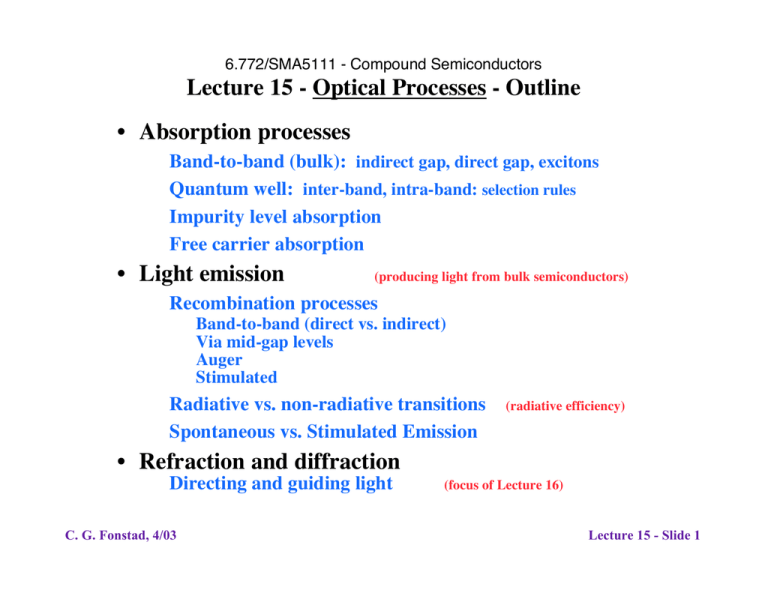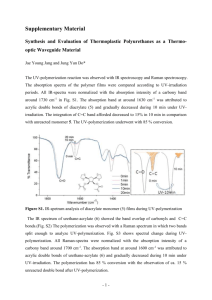Lecture 15 - Optical Processes - Outline Absorption processes Light emission
advertisement

6.772/SMA5111 - Compound Semiconductors Lecture 15 - Optical Processes - Outline • Absorption processes Band-to-band (bulk): indirect gap, direct gap, excitons Quantum well: inter-band, intra-band: selection rules Impurity level absorption Free carrier absorption • Light emission (producing light from bulk semiconductors) Recombination processes Band-to-band (direct vs. indirect) Via mid-gap levels Auger Stimulated Radiative vs. non-radiative transitions Spontaneous vs. Stimulated Emission (radiative efficiency) • Refraction and diffraction Directing and guiding light C. G. Fonstad, 4/03 (focus of Lecture 16) Lecture 15 - Slide 1 Absorption in semiconductors: reflection and absorption coefficients Light normally incident on a solid will be partially reflected at the air (or vacuum) and solid interface, and the remaining light will enter the solid. If it is absorbed by the solid, its intensity will decrease exponentially with distance as e-a(l)x, where a(l) is the absorption coefficient. I(l, x ) = [1- R( l )] Io(l ) e-a ( l) x where R(l) is the reflection coefficient at the interface. We will say more about R(l) shortly, but first discuss a(l). C. G. Fonstad, 4/03 † Lecture 15 - Slide 2 Absorption in semiconductors - energy level systems • We will look at energy transitions in bulk and quantum well systems C. G. Fonstad, 4/03 Lecture 15 - Slide 3 Absorption in semiconductors: processes Within these energy level systems we can have a variety of mechanisms by which electrons (and holes) absorb optical energy. Most of these processes can occur in quantum wells, wires, and dots, as well as in bulk material. : Band-to-band: an electron in the valence band absorbs a photon with enough energy to be excited to the conduction band, leaving a hole behind. Band-to-exciton: an electron in the valence band absorbs almost enough energy to be excited to the conduction band. The electron and hole it leaves behind remain electrically "bound" together, much like the electron and proton of a hydrogen atom. Band-to-impurity or impurity to band: an electron absorbs a photon that excites it from the valence band to an empty impurity atom, or from an occupied impurity atom to the conduction band. Cont. next foil C. G. Fonstad, 4/03 Lecture 15 - Slide 4 Absorption in semiconductors: processes cont. Free carrier: an electron in the conduction band, or hole in the valence band, absorbs a photon an is excited to a higher energy level within the same set of bands (i.e, conduction or valence). In quantum structures there can be photon absorption due to carriers being excited between the quantum levels within the same band (termed "intra-band"), as well as between the various quantum levels in one band and those in another "(inter-band"): Intra-band: these transitions can occur only between even and odd index levels and are only operative for light polarized parallel to the direction of quantization. That is, in a quantum well the light must be polarized normal to the well itself, and in the direction of the composition variation. Inter-band: inter-band transitions can occur between conduction and valence bands, or between different valence bands (light-hole, heavy-hole, and spin-off). There are transitions can be active for either polarization of the light, depending on the symmetries of the respective bands. C. G. Fonstad, 4/03 Lecture 15 - Slide 5 Absorption in semiconductors - band-to-band • Comparing direct and indirect band gap absorption Transitions (Image deleted) Direct gap (Image deleted) Indirect gap Absorption Edges (Image deleted) (Image deleted) See Fig. 5.1: Swaminathan, V. and Macrander, A.T., Materials Aspects of GaAs and InP Based Structures. Englewood Cliffs, N.J.: Prentice-Hall, 1991. C. G. Fonstad, 4/03 (Swaminathan and Macrander, Fig. 5.1) Lecture 15 - Slide 6 Absorption in semiconductors: band-to-band Direct-gap: Direct-gap absorption involves only a single electron and a photon. Single electron theory (which ignors the possibility of excitons) tells us that the absorption coefficient for direct-gap absorption varies as the square-root of energy above the band edge: 1/ 2 a direct ( hn ) = Adirect [hn - E g ] gap u1 ( hn - E g ) gap Indirect-gap: Indirect-gap absorption requires the absorption or emission of a phonon, as well of a photon. In this case single electron theory tells us that the absorption coefficient for directgap absorption varies † as the square of energy above onset: a indirct( hn ) = A phonon gap absorption + A phonon absorption [hn - ( E [hn - ( E g g 2 ] u (hn - E - E ph ) 1 2 ] u (hn - E + E ph ) 1 g g + E ph ) - E ph ) Bottom line: Direct-gap absorption is more abrupt, and more intense than indirect-gap absorption. C. G. Fonstad, 4/03 † Lecture 15 - Slide 7 Absorption in semiconductors - bulk band-to-band • Comparison of the absorption edge of several direct- and indirect-gap semiconductors Notice the abruptness of the absorption edge, and the difference in the strength of the absorption just above the band-edge. C. G. Fonstad, 4/03 Lecture 15 - Slide 8 Absorption in semiconductors - band-edge tail • Sub-gap absortpion Note: Some subgap absorption is due to impurities and some is due to polar optical phonons. In this high purity sample it is due to the later, an effect termed the FranzKeldysh Effect. (Image deleted) GaAs sample R.T. See Fig. 5.2: Swaminathan, V. and Macrander, A.T., Materials Aspects of GaAs and InP Based Structures. Englewood Cliffs, N.J.: Prentice-Hall, 1991. C. G. Fonstad, 4/03 Lecture 15 - Slide 9 Absorption in semiconductors - excitonic absorption near 0 K • Structure seen at very low temperatures The sharpest spectra are obtained at very low temperatures where the photon population is low. (Image deleted) Note the sharp rise in absorption in the exciton continuum, and compare it to the bulk theory ignoring excitons (dashed line) See Fig. 5.24: Swaminathan, V. and Macrander, A.T., Materials Aspects of GaAs and InP Based Structures. Englewood Cliffs, N.J.: Prentice-Hall, 1991. C. G. Fonstad, 4/03 Lecture 15 - Slide 10 Absorption in semiconductors - exciton absorption vs. T • Spectra for GaAs and InP at various temperatures GaAs InP (Image deleted) (Image deleted) See Fig. 5.5, 5.6: Swaminathan, V. and Macrander, A.T., Materials Aspects of GaAs and InP Based Structures. Englewood Cliffs, N.J.: Prentice-Hall, 1991. C. G. Fonstad, 4/03 Lecture 15 - Slide 11 Absorption in semiconductors - free carrier (hole) absorption • Valence band free carrier absorption Note: The free carrier absorption spectum for electrons has a simple l2 variation, but there are multiple valence bands and as a consequence the hole free carrier spectrum is more complex, with peaks at valence band to valence band resonances. (Image deleted) See Fig. 5.10: Swaminathan, V. and Macrander, A.T., Materials Aspects of GaAs and InP Based Structures. Englewood Cliffs, N.J.: Prentice-Hall, 1991. C. G. Fonstad, 4/03 Lecture 15 - Slide 12 Absorption in semiconductors - quantum well spectra • Theory and experiment Theorectical curve: (Image deleted) Data: (Image deleted) Note the excitons at each subband step edge. C. G. Fonstad, 4/03 See Fig. 8.B.3: Rosencher, E. and Vinter B., Optoelectronics Cambridge, UK; New York NY: Cambridge University Press, 2002. Lecture 15 - Slide 13 Absorption in semiconductors - quantum well excitons with an applied electric field • Changing with a field: the basis for a device (Image deleted) We shall see that this can be used to make a light modulator. See Fig.52: Weisbuch, C. and Vinter B., Quantum Semiconductor Structures: fundamentals and applications Boston: Academic Press, 1991. C. G. Fonstad, 4/03 Lecture 15 - Slide 14 Recombination in semiconductors - various processes • Hole-electron recombination The processes that occur in any semiconductor. Some are radiative, many are not. (Images deleted) See Fig. 5.16: Swaminathan, V. and Macrander, A.T., Materials Aspects of GaAs and InP Based Structures. Englewood Cliffs, N.J.: Prentice-Hall, 1991 Band-to-band recombination is radiative, but it is very slow in indirect semiconductors, and it cannot compete with non-radiative processes. C. G. Fonstad, 4/03 Lecture 15 - Slide 15





